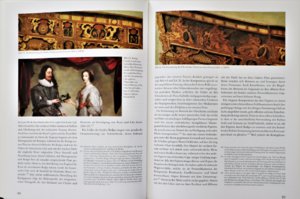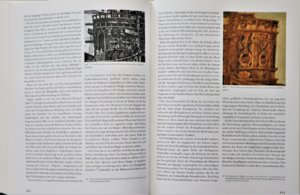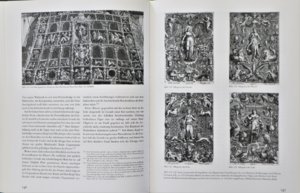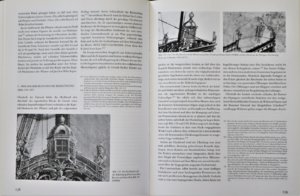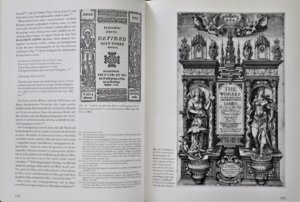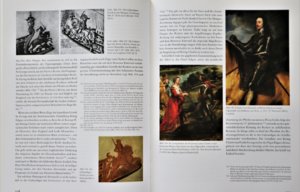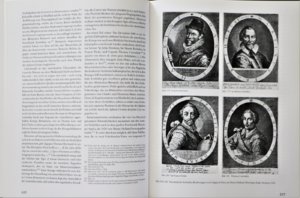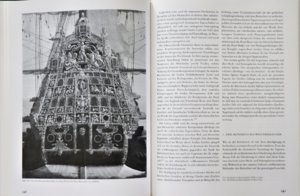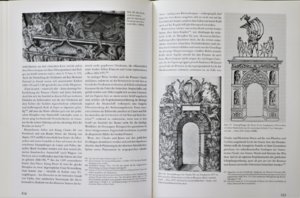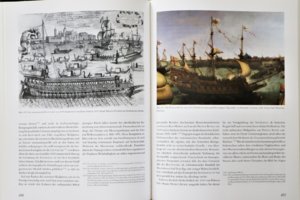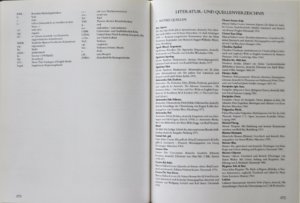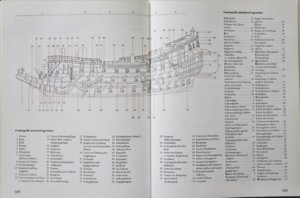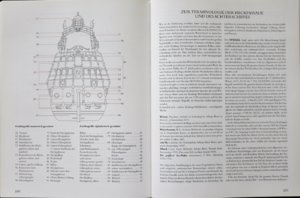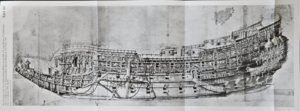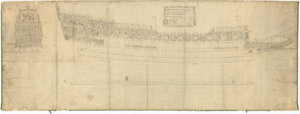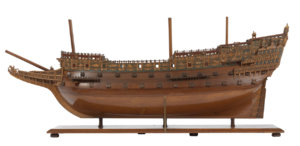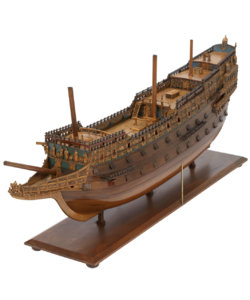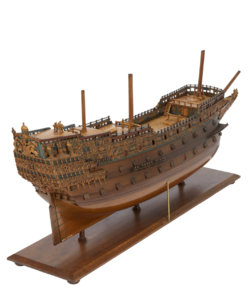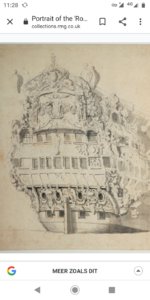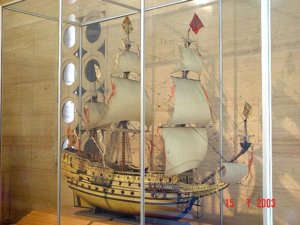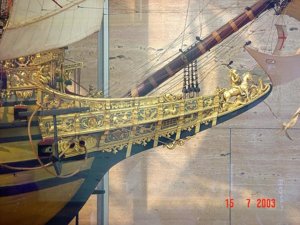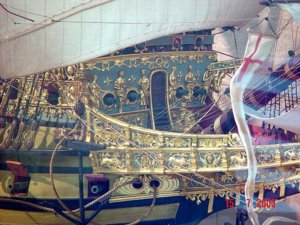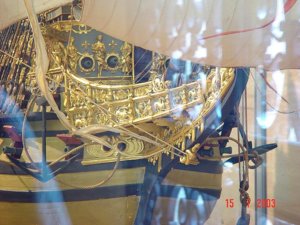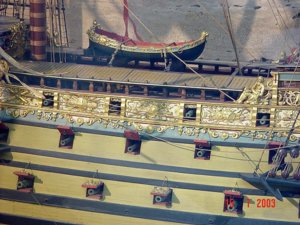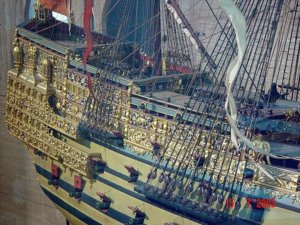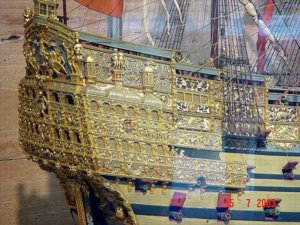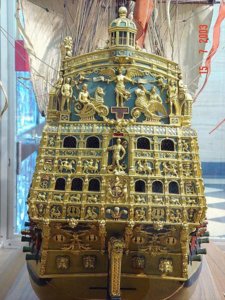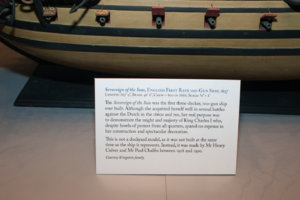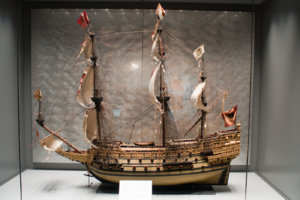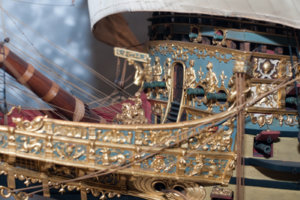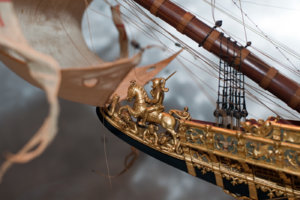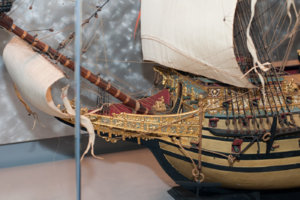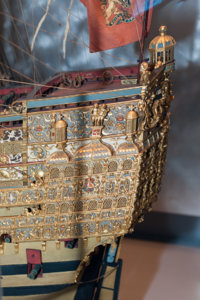Book Review:
SOVEREIGN OF THE SEAS
- Die Skulpturen des britischen Königsschiffes von 1637
by Hendrik Busmann
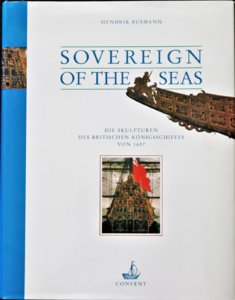
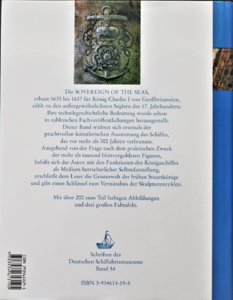
Doctor Thesis originally published by Convent - organised by Deutsches Schifffahrtsmuseum
 ww3.dsm.museum
ww3.dsm.museum
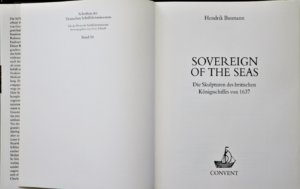
SYNOPSIS:
original in german
Die SOVEREIGN OF THE SEAS, erbaut 1635 bis 1637 für König Charles I. von Großbritannien, zählt zu den außergewöhnlichsten Seglern des 17. Jahrhunderts. Ihre technikgeschichtliche Bedeutung wurde schon in zahlreichen Fachveröffentlichungen herausgestellt. Dieser Band, illustriert mit über zweihundert zum Teil farbigen Abbildungen und drei großen Faltplänen, widmet sich erstmals der prachtvollen künstlerischen Ausstattung des Schiffes, das vor mehr als 300 Jahren verbrannte.
Ausgehend von der Frage nach dem praktischen Zweck der mehr als tausend blattvergoldeten Figuren, befaßt sich Hendrik Busmann mit den Funktionen des Königsschiffes als Medium herrscherlicher Selbstdarstellung. Dabei wird deutlich, daß es sich entgegen landläufiger Meinung keineswegs um bloße Dekoration handelt. Dem Schnitzwerk liegt vielmehr ein komplexes ikonographisches Programm zugrunde, welches elementare Repräsentationsaufgaben erfüllt und deshalb einen unverzichtbaren Bestandteil des Gesamtkunstwerkes bildet.
Im zweiten Teil des Buches folgt eine umfassende Deutung des Programms. Vor dem kulturgeschichtlichen Hintergrund absolutistischer Herrscherideologie, deren Wurzeln bis ins Mittelalter zurückreichen, eröffnet sich dem Leser die Geisteswelt der frühen Stuartkönige. Er erhält damit den Schlüssel zum Verständnis der in allegorischer »Bildsprache« komponierten Skulpturenzyklen.
So liefert Busmann nicht nur einen wichtigen Forschungsbeitrag zum Schiff, sondern weist auch neue Wege zu einer angemessenen Würdigung der tragischen und oft mißverstandenen Person Charles' I. Die akribische Arbeit Busmanns wurde im Dezember 2004 mit dem von der Philisophischen Fakultät der Universität zu Köln verliehenen Preis der Offermann-Hergarten-Stiftung ausgezeichnet.
Translated into english
The SOVEREIGN OF THE SEAS, built between 1635 and 1637 for King Charles I of Great Britain, is one of the most extraordinary sailing ships of the 17th century. Its importance in terms of technical history has already been emphasized in numerous specialist publications. This volume, illustrated with over two hundred partially colored illustrations and three large folding plans, is dedicated for the first time to the magnificent artistic equipment of the ship, which was destroyed by fire more than 300 years ago.
Starting from the question of the practical purpose of the more than a thousand leaf-gilt figures, Hendrik Busmann deals with the functions of the royal ship as a medium of authoritative self-representation. It becomes clear that, contrary to popular opinion, it is by no means mere decoration. Rather, the carving is based on a complex iconographic program that fulfills elementary representational tasks and therefore forms an indispensable component of the Gesamtkunstwerk.
The second part of the book is followed by a comprehensive interpretation of the program. Against the cultural-historical background of absolutist ruler ideology, whose roots date back to the Middle Ages, the reader opens up the spiritual world of the early Stuart kings. He thus receives the key to understanding the sculpture cycles composed in allegorical »imagery«.
Thus, Busmann not only provides an important research contribution to the ship, but also points out new ways for a proper appreciation of the tragic and often misunderstood person Charles' I. The meticulous work of Busmann was in December 2004 awarded by the Faculty of Philosophy of the University of Cologne awarded the Offermann Hergarten Foundation.
the book with the three fold out plates
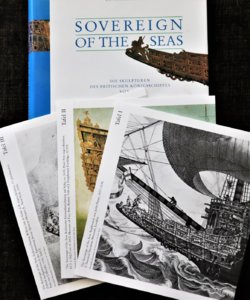
About the Author
Hendrik Busmann, Jahrgang 1955, studierte Kunstgeschichte, Archäologie und Volkskunde an den Universitäten Köln und Bonn und promovierte 1998 mit dem vorliegenden Werk. Neben seiner wissenschaftlichen Forschungsarbeit sammelte er auch Erfahrungen in praktischer Seemannschaft bei Fahrten als Deckshand, Bootsmann und Takler auf Rah- und Gaffelseglern.
Hendrik Busmann, born in 1955, studied art history, archeology and folklore at the Universities of Cologne and Bonn and obtained his doctorate in 1998 with the present work. In addition to his scientific research work, he also gained experience in practical seamanship during trips as a deckhand, boatswain and riggers on Rah and Gaffelseglern.
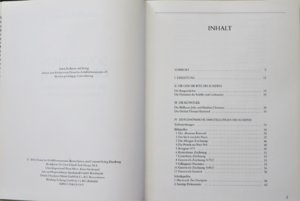
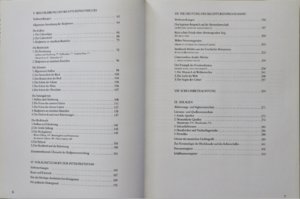
Content:
I. Vorwort und Einleitung
II. Die Geschichte des Schiffes
- Die Baugeschichte
- Die Dienstzeit des Schiffes (mit Umbauten)
III. Die Künstler
- Die Bildhauer John und Matthias Christmas
- Der Dichter Thomas Heywood
IV. Zeitgenössische Darstellungen des Schiffes
- Vorbemerkungen
- Bildquellen
1. Der „Bostoner Entwurf“
2. Der Stich von John Payne
3. Die „Morgan-Zeichnung“
4. Das Porträt mit Peter Pett
5. Kriegsrat 1673
6. Rotterdamer Zeichnung
7. Canterbury Zeichnung
8. Greenwich-Zeichnung 1675 (?)
9. Gillingham-Panorama
10. Greenwich-Zeichnung 1685 (?)
11. Greenwich-Seestück
Schriftquellen
1. Heywoods „True Description“
2. Sonstige Dokumente
V. Beschreibung des Skulpturenschmucks
- Vorbemerkungen
- Allgemeine Anordnung der Skulpturen
- Das Galion
- Die Bordwände
- Die Schotten
- Die Seitengalerien
- Die Heckfassade
- Zusammenfassende Übersicht der Skulpturenverteilung
VI. Voraussetzungen zur Interpretation
- Vorbemerkungen
- Kunst und Rhetorik
- Von der Ideologie absolutistischen Königtums
- Der politische Hintergrund
VII. Die Deutung des Skulpturenprogramms
- Vorbemerkungen
- Der legitime Anspruch auf die Meeresherrschaft
- Kein echter Friede ohne überzeugenden Sieg
- Wahre Fürstentugenden
- Strahlende Helden aus der Geschichte Britanniens
- Unterworfene dunkle Mächte
- Der Triumph des Friedenfürsten
1. Der Monarch als Weltherrscher
2. Das Licht der Welt
3. Der Segen der Götter
VIII. Schlussbetrachtung
IX. Anlagen und Quellenverzeichnis
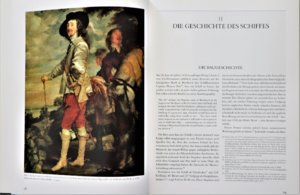
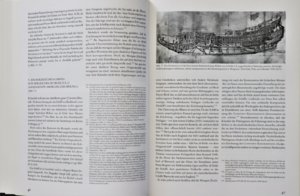
Comment & Recommendation
The book draws a very own way on how to deal with a ship. The author provides a whole new look at the subject of "ornaments", since he has dealt intensively with the ornaments of the "Sovereign of the Seas" and thus probably one of the few authors who in detail discuss such a magnificent ship from a completely different perspective. This is definitely successful for the author, the part of the book, where he swings towards interpretations and interpretations, certainly provides the greatest potential for criticizing this work. Nevertheless, it was very interesting to read this dissertation, because it combines history with art in a very successful way. The writing style of the work is of course very scientific and well over 1000 footnotes and a very interesting appendix do the rest. In general you should have read this book quite well, as it is interesting for history friends, as well as for modelers alike
It comes with three inserts, which include the view of the hull from port side from the Payne engraving, the Van de Velde sketch of the port side and the painting from the Museum of Fine Arts Boston of the starboard side which is attributed to Peter Pett.
The book is written in German but does provide a wealth of information in photos with closeups of specific areas on the hull.
- highly recommended.
More Look Inside:
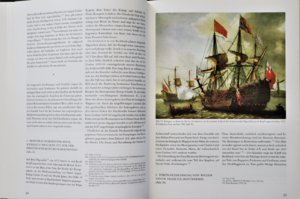
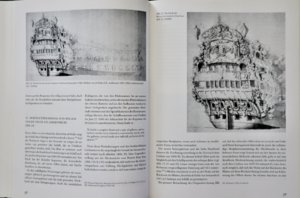

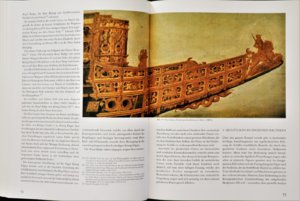

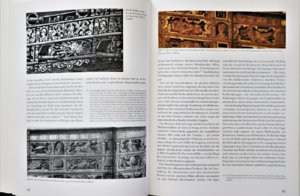
You can find more look inside photos in the following post ......
SOVEREIGN OF THE SEAS
- Die Skulpturen des britischen Königsschiffes von 1637
by Hendrik Busmann


- Gebundene Ausgabe: 311 Seiten
- Verlag: CONVENT Hamburg (2002)
- Sprache: Deutsch
- ISBN-10: 3934613195
- ISBN-13: 978-3934613195
- Verpackungsabmessungen: 27,4 x 21,5 x 3 cm / 1.580 gramm
Doctor Thesis originally published by Convent - organised by Deutsches Schifffahrtsmuseum
SOVEREIGN OF THE SEAS - Deutsches Schiffahrtsmuseum

SYNOPSIS:
original in german
Die SOVEREIGN OF THE SEAS, erbaut 1635 bis 1637 für König Charles I. von Großbritannien, zählt zu den außergewöhnlichsten Seglern des 17. Jahrhunderts. Ihre technikgeschichtliche Bedeutung wurde schon in zahlreichen Fachveröffentlichungen herausgestellt. Dieser Band, illustriert mit über zweihundert zum Teil farbigen Abbildungen und drei großen Faltplänen, widmet sich erstmals der prachtvollen künstlerischen Ausstattung des Schiffes, das vor mehr als 300 Jahren verbrannte.
Ausgehend von der Frage nach dem praktischen Zweck der mehr als tausend blattvergoldeten Figuren, befaßt sich Hendrik Busmann mit den Funktionen des Königsschiffes als Medium herrscherlicher Selbstdarstellung. Dabei wird deutlich, daß es sich entgegen landläufiger Meinung keineswegs um bloße Dekoration handelt. Dem Schnitzwerk liegt vielmehr ein komplexes ikonographisches Programm zugrunde, welches elementare Repräsentationsaufgaben erfüllt und deshalb einen unverzichtbaren Bestandteil des Gesamtkunstwerkes bildet.
Im zweiten Teil des Buches folgt eine umfassende Deutung des Programms. Vor dem kulturgeschichtlichen Hintergrund absolutistischer Herrscherideologie, deren Wurzeln bis ins Mittelalter zurückreichen, eröffnet sich dem Leser die Geisteswelt der frühen Stuartkönige. Er erhält damit den Schlüssel zum Verständnis der in allegorischer »Bildsprache« komponierten Skulpturenzyklen.
So liefert Busmann nicht nur einen wichtigen Forschungsbeitrag zum Schiff, sondern weist auch neue Wege zu einer angemessenen Würdigung der tragischen und oft mißverstandenen Person Charles' I. Die akribische Arbeit Busmanns wurde im Dezember 2004 mit dem von der Philisophischen Fakultät der Universität zu Köln verliehenen Preis der Offermann-Hergarten-Stiftung ausgezeichnet.
Translated into english
The SOVEREIGN OF THE SEAS, built between 1635 and 1637 for King Charles I of Great Britain, is one of the most extraordinary sailing ships of the 17th century. Its importance in terms of technical history has already been emphasized in numerous specialist publications. This volume, illustrated with over two hundred partially colored illustrations and three large folding plans, is dedicated for the first time to the magnificent artistic equipment of the ship, which was destroyed by fire more than 300 years ago.
Starting from the question of the practical purpose of the more than a thousand leaf-gilt figures, Hendrik Busmann deals with the functions of the royal ship as a medium of authoritative self-representation. It becomes clear that, contrary to popular opinion, it is by no means mere decoration. Rather, the carving is based on a complex iconographic program that fulfills elementary representational tasks and therefore forms an indispensable component of the Gesamtkunstwerk.
The second part of the book is followed by a comprehensive interpretation of the program. Against the cultural-historical background of absolutist ruler ideology, whose roots date back to the Middle Ages, the reader opens up the spiritual world of the early Stuart kings. He thus receives the key to understanding the sculpture cycles composed in allegorical »imagery«.
Thus, Busmann not only provides an important research contribution to the ship, but also points out new ways for a proper appreciation of the tragic and often misunderstood person Charles' I. The meticulous work of Busmann was in December 2004 awarded by the Faculty of Philosophy of the University of Cologne awarded the Offermann Hergarten Foundation.
the book with the three fold out plates

About the Author
Hendrik Busmann, Jahrgang 1955, studierte Kunstgeschichte, Archäologie und Volkskunde an den Universitäten Köln und Bonn und promovierte 1998 mit dem vorliegenden Werk. Neben seiner wissenschaftlichen Forschungsarbeit sammelte er auch Erfahrungen in praktischer Seemannschaft bei Fahrten als Deckshand, Bootsmann und Takler auf Rah- und Gaffelseglern.
Hendrik Busmann, born in 1955, studied art history, archeology and folklore at the Universities of Cologne and Bonn and obtained his doctorate in 1998 with the present work. In addition to his scientific research work, he also gained experience in practical seamanship during trips as a deckhand, boatswain and riggers on Rah and Gaffelseglern.


Content:
I. Vorwort und Einleitung
II. Die Geschichte des Schiffes
- Die Baugeschichte
- Die Dienstzeit des Schiffes (mit Umbauten)
III. Die Künstler
- Die Bildhauer John und Matthias Christmas
- Der Dichter Thomas Heywood
IV. Zeitgenössische Darstellungen des Schiffes
- Vorbemerkungen
- Bildquellen
1. Der „Bostoner Entwurf“
2. Der Stich von John Payne
3. Die „Morgan-Zeichnung“
4. Das Porträt mit Peter Pett
5. Kriegsrat 1673
6. Rotterdamer Zeichnung
7. Canterbury Zeichnung
8. Greenwich-Zeichnung 1675 (?)
9. Gillingham-Panorama
10. Greenwich-Zeichnung 1685 (?)
11. Greenwich-Seestück
Schriftquellen
1. Heywoods „True Description“
2. Sonstige Dokumente
V. Beschreibung des Skulpturenschmucks
- Vorbemerkungen
- Allgemeine Anordnung der Skulpturen
- Das Galion
- Die Bordwände
- Die Schotten
- Die Seitengalerien
- Die Heckfassade
- Zusammenfassende Übersicht der Skulpturenverteilung
VI. Voraussetzungen zur Interpretation
- Vorbemerkungen
- Kunst und Rhetorik
- Von der Ideologie absolutistischen Königtums
- Der politische Hintergrund
VII. Die Deutung des Skulpturenprogramms
- Vorbemerkungen
- Der legitime Anspruch auf die Meeresherrschaft
- Kein echter Friede ohne überzeugenden Sieg
- Wahre Fürstentugenden
- Strahlende Helden aus der Geschichte Britanniens
- Unterworfene dunkle Mächte
- Der Triumph des Friedenfürsten
1. Der Monarch als Weltherrscher
2. Das Licht der Welt
3. Der Segen der Götter
VIII. Schlussbetrachtung
IX. Anlagen und Quellenverzeichnis


Comment & Recommendation
The book draws a very own way on how to deal with a ship. The author provides a whole new look at the subject of "ornaments", since he has dealt intensively with the ornaments of the "Sovereign of the Seas" and thus probably one of the few authors who in detail discuss such a magnificent ship from a completely different perspective. This is definitely successful for the author, the part of the book, where he swings towards interpretations and interpretations, certainly provides the greatest potential for criticizing this work. Nevertheless, it was very interesting to read this dissertation, because it combines history with art in a very successful way. The writing style of the work is of course very scientific and well over 1000 footnotes and a very interesting appendix do the rest. In general you should have read this book quite well, as it is interesting for history friends, as well as for modelers alike
It comes with three inserts, which include the view of the hull from port side from the Payne engraving, the Van de Velde sketch of the port side and the painting from the Museum of Fine Arts Boston of the starboard side which is attributed to Peter Pett.
The book is written in German but does provide a wealth of information in photos with closeups of specific areas on the hull.
- highly recommended.
More Look Inside:






You can find more look inside photos in the following post ......


